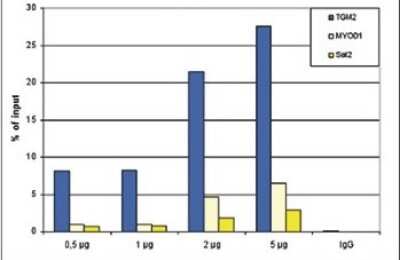Histone H3 [Dimethyl Lys36] Antibody (C.15200182)
Novus Biologicals, part of Bio-Techne | Catalog # NBP2-59296

Key Product Details
Species Reactivity
Validated:
Human
Applications
Chromatin Immunoprecipitation (ChIP), Dot Blot, ELISA, Western Blot
Label
Unconjugated
Antibody Source
Monoclonal Mouse IgG1 Clone # C.15200182
Concentration
Please see the vial label for concentration. If unlisted please contact technical services.
Product Summary for Histone H3 [Dimethyl Lys36] Antibody (C.15200182)
Immunogen
The exact sequence of the immunogen to this Histone H3 [Dimethyl Lys36] antibody (C.15200182) is proprietary.
Modification
Dimethyl Lys36
Clonality
Monoclonal
Host
Mouse
Isotype
IgG1
Theoretical MW
15 kDa.
Disclaimer note: The observed molecular weight of the protein may vary from the listed predicted molecular weight due to post translational modifications, post translation cleavages, relative charges, and other experimental factors.
Disclaimer note: The observed molecular weight of the protein may vary from the listed predicted molecular weight due to post translational modifications, post translation cleavages, relative charges, and other experimental factors.
Scientific Data Images for Histone H3 [Dimethyl Lys36] Antibody (C.15200182)
Chromatin Immunoprecipitation: Histone H3 [Dimethyl Lys36] Antibody (C.15200182) [NBP2-59296] - ChIP assays were performed using human HeLa cells, the antibody against H3K36me2 and optimized PCR primer pairs for qPCR. ChIP was performed with the Auto Histone ChIP-seq kit, using sheared chromatin from 1 million cells. A titration consisting of 0.5, 1, 2 and 5 ug of antibody per ChIP experiment was analyzed. IgG (1 ug/IP) was used as a negative IP control. Quantitative PCR was performed with primers specific for a genomic region upstream of the TGM2 gene, used as a positive control, and for the inactive MYOD1 gene and the Sat2 satellite repeat, used as negative controls. Figure shows the recovery, expressed as a % of input (the relative amount of immunoprecipitated DNA compared to input DNA after qPCR analysis).
ELISA: Histone H3 [Dimethyl Lys36] Antibody (C.15200182) [NBP2-59296] - Cross reactivity of the antibody directed against H3K36me2. To test the specificity an ELISA was performed using a serial dilution of the antibody against H3K36me2. The wells were coated with peptides containing the unmodified H3K36 region as well as the mono-, di- and trimethylated H3K36 and the trimethylated H3K9. Figure shows a high specificity of the antibody for the peptide containing the modification of interest.
Applications for Histone H3 [Dimethyl Lys36] Antibody (C.15200182)
Application
Recommended Usage
Chromatin Immunoprecipitation (ChIP)
1-2 ug/IP
Dot Blot
1:10000
ELISA
1:3000
Western Blot
1:1000 - 1:2000
Please Note: Optimal dilutions of this antibody should be experimentally determined.
Formulation, Preparation, and Storage
Purification
Protein A purified
Formulation
PBS
Preservative
0.05% Sodium Azide
Concentration
Please see the vial label for concentration. If unlisted please contact technical services.
Shipping
The product is shipped with polar packs. Upon receipt, store it immediately at the temperature recommended below.
Stability & Storage
Store at -20C. Avoid freeze-thaw cycles.
Background: Histone H3
Histones are nuclear proteins responsible for the nucleosome structure of the chromosomal fiber in eukaryotes. Changes in chromatin structure play a large role in the regulation of transcription. The chromatin fibers are compacted through the interaction of a linker histone, H1, with the DNA between the nucleosomes to form higher order chromatin structures.
Common histone modifications include methylation of lysine and arginine, acetylation of lysine, phosphorylation of threonine and serine, and sumoylation, biotinylation, and ubiquitylation of lysine. Posttranslational modifications such as acetylation of core histones regulates gene expression, thus altering protein function and regulation (1). Histone H3 is primarily acetylated at lysines 9, 14, 18, and 23 and have a theoretical molecular weight of 15 kDa. Acetylation at lysine 9 and 14 appears to control histone deposition, chromatin assembly and active transcription. Methylation of arginine residues within histone H3 has also been linked to transcription regulation. Histone H3 has been linked to various types of cancer as a biomarker through the aberrant expression of histone deacetylase (HDAC) enzymes and changes to chromatins (2-4).
References
1. Zhang, Y. X., Akumuo, R. C., Espana, R. A., Yan, C. X., Gao, W. J., & Li, Y. C. (2018). The histone demethylase KDM6B in the medial prefrontal cortex epigenetically regulates cocaine reward memory. Neuropharmacology, 141, 113-125. doi:10.1016/j.neuropharm.2018.08.030
2. Nandakumar, V., Hansen, N., Glenn, H. L., Han, J. H., Helland, S., Hernandez, K, ...Meldrum, D. R. (2016). Vorinostat differentially alters 3D nuclear structure of cancer and non-cancerous esophageal cells. Sci Rep, 6, 30593. doi:10.1038/srep30593
3. Zhou, M., Li, Y., Lin, S., Chen, Y., Qian, Y., Zhao, Z., & Fan, H. (2019). H3K9me3, H3K36me3, and H4K20me3 Expression Correlates with Patient Outcome in Esophageal Squamous Cell Carcinoma as Epigenetic Markers. Dig Dis Sci, 64(8), 2147-2157. doi:10.1007/s10620-019-05529-2
4. Li, Y., Guo, D., Sun, R., Chen, P., Qian, Q., & Fan, H. (2019). Methylation Patterns of Lys9 and Lys27 on Histone H3 Correlate with Patient Outcome in Gastric Cancer. Dig Dis Sci, 64(2), 439-446. doi:10.1007/s10620-018-5341-8
Alternate Names
H3F3A, H3K36Me2
Gene Symbol
H3C14
Additional Histone H3 Products
Product Documents for Histone H3 [Dimethyl Lys36] Antibody (C.15200182)
Product Specific Notices for Histone H3 [Dimethyl Lys36] Antibody (C.15200182)
This product is for research use only and is not approved for use in humans or in clinical diagnosis. Primary Antibodies are guaranteed for 1 year from date of receipt.
